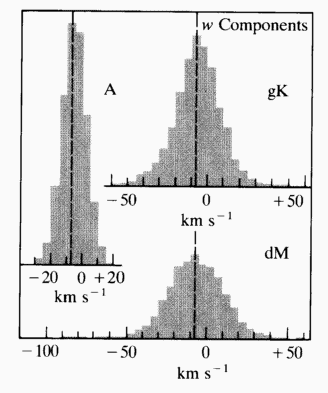- A stars ("A")
- K giants ("gK")
- M dwarfs ("dM")
-
(what is different about these groups
of stars?)
|
|
(km/s) |
|
|
|
|
|
|
|
|
|
|
|
|

Make a histogram of the w
(up/down) velocities
of stars of different spectral type:
|
 |
Remember also that different groups of stars had
different
disk thicknesses:
|
|
(km/s) |
(pc) |
|
|
|
|
|
|
|
|
|
|
|
|
|
|
|
|
|
|
|
|
Question #1: Why does dispersion increase with spectral type?Question #2: Why do dispersion and scale height increase together?
The disk is not perfectly smooth -- there are "lumps" of matter (what kind of lumps?)As stars move through these lumps, they scatter gravitationally, increasing their random velocities and moving from circular orbits to elliptical orbits. As a group, their velocity dispersion increases.
Why are they born on circular orbits?
Imagine the disk as a plane parallel slab of mass. Gravity pulls stars towards the disk, their velocities can carry them away. We want to balance these two effects:
So if we measure velocity dispersions and scale heights for groups of stars, we can measure the mass density of the Galaxy's disk. This was first done in the early 1930s by Jan Oort and is called the Oort limit. Modern analyses gives ~ 75 Msun/pc2 or so.
Now let's just add up all the mass we see:
Stars 30 Msun/pc2 Stellar remnants
(mostly WDs)5 Msun/pc2 Brown Dwarfs
2 Msun/pc2 Gas (HI+H2) 13 Msun/pc2 Total 50 Msun/pc2 Hmm. What's going on??